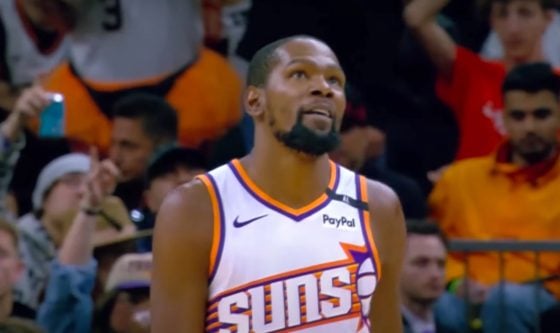Mazzulla-ball is here, and it’s a beautiful sight. A highly analytically based offensive approach that has seen the Celtics become one of the most fearsome perimeter scoring teams in the NBA, while also pressuring the rim at a jaw-dropping rate.
Talk to any Celtics fan, and they’ll tell you they’re in love with the team’s offense to begin the season, and they’re especially happy with how Jayson Tatum and Jaylen Brown are thriving in roles that have less individual playmaking situated on their shoulders. Mazzulla-ball goes deeper than shooting tons of threes and liberating the team’s best players though — it ensures every member of the rotation has a chance to be a featured offensive weapon, and that those without the ball remain an integral cog in each individual possession.
And that’s where our focus will be today. Not on the makes and misses, or the players who are getting opportunities to shine, but rather, the off-ball actions that are making everything else possible. The selfless, non-trackable, oft-overlooked movements that gel everything together.
Let’s start with the above possession, a transition play that sees Sam Hauser splash through the net with a shot directly off the catch. On first look, it appears that Derrick White is the creator of this bucket, engaging his defender before finding Hauser on the weak side. However, Luke Kornet certainly had a hand in creating such a wide-open look, streaking towards the nail before setting a flare-ish screen for Hauser to drift towards the slot before releasing the shot as soon as he feels the ball touches his hands.
Kornet almost took John Collins completely out of that defensive possession, and it resulted in a non-contested jumper, where Hauser only began to feel the defensive pressure as he was releasing the shot — far too late to have any significant impact on the shooting trajectory or release speed.
Here’s another example of using off-ball screening actions to generate some separation from the defense as the Celtics look to create a shooting pocket for one of their three-point threats. This time, we see Boston run an ‘STS’ action, which simply means ‘screen the screener’ where the initial screen setter then receives a screen themselves. In this instance, it starts with Hauser setting a ‘wedge screen’ for Jayson Tatum, before receiving a down screen from Kornet.
The benefits of this action are two-fold. Initially, Hauser’s screen forces Dejounte Murray to switch off Tatum, which gives Tatum a mismatch if he looks to attack off the dribble (should he receive the ball, of course). And secondly, Kornet’s screen consumes Murray, giving Hauser the space needed to re-locate onto the perimeter and get his shot off without the need to adjust for a defending stampeding toward him on a close-out.
It helps that Boston has one of the best players in the league (Tatum) spacing the court in the corner too, because the Atlanta Hawks, or any other team, will always be wary of helping off of Tatum, thus creating additional space in which the Celtics can attack or look to screen a defender out of possession.
Furthermore, the Celtics are benefitting from having so many shooting threats this season, so much so, that their off-ball screening has ensured a large majority of Boston’s shots are either ‘open’ or ‘wide open’ — let’s take a look at the numbers to confirm this before we continue with our dive into the film.
Celtics Shot Attempts By Defender Distance
| Defender Distance | FGA | FGA League Ranking | FG% | FG% League Ranking |
|---|---|---|---|---|
| Defender Distance | FGA | FGA League Ranking | FG% | FG% League Ranking |
| Very Tight (Defender 0-2 Feet Away) | 6.6 | 14th | 42.4% | 23rd |
| Tight (Defender 2-4 Feet Away) | 32.7 | 28th | 52% | 11th |
| Open (Defender 4-6 Feet Away) | 26.5 | 11th | 50.9% | 2nd |
| Wide Open (Defender More Than 6 Feet Away) | 21.5 | 8th | 43.2% | 8th |
NBA Stats
On average, the Celtics are taking 87.3 shots per game, 48 of which are either open or wide open, meaning roughly 55% of their shots are coming without a defender close enough to impact shooting motion and/or shot trajectory. So, it would appear the eye test is being upheld by the statistics.
Ok, back to the film.
A staple of Boston’s half-court offense this season has been using Spain pick-and-rolls as entry sets, meaning Mazzulla has his team running this action as a way to get the defense in motion while giving the ball-handler multiple options, with the primary three being: hit the rip screener who is popping onto the perimeter (the popper), fire a pass into the rolling big man, or drive at the defense yourself and take whatever it is they give you.
Most teams in the league run Spain pick-and-rolls as an action, where they’re looking to score directly off the play. Boston, however, is often using it as nothing more than a decoy action to create wrinkles in their opponents’ coverage, before making the necessary reads to find or create an open shooting opportunity, either from deep or at the rim.
As we can see in the above clip, Al Horford is the initial screener, with Tatum occupying the role of ‘popper’. As the action unfolds, Derrick White sees a direct line to the bucket and forces himself into the paint before extending for a one-handed lay-up off the glass.
Below, we can see the Celtics going back to this Spain entry, this time with Kornet and Payton Pritchard as the screeners. We get a similar result, with White driving the lane and pressuring the rim before getting the shot to fall. However, if the defense had collapsed, Pritchard would have been a reliable outlet above the break, and Kornet was hovering around for the dump-off pass — one simple entry ensured the Celtics had multiple ways to counter how the defense wanted to play them.
The final off-ball screening action we’re going to look at has been another staple of Mazzulla-ball: the weakside stagger twirl.
Similar to Boston’s usage of the Spain pick-and-roll, the Celtics are using twirl actions as a weakside decoy and/or entry into their half-court offense. The premise of utilizing a twirl action on the weak side is that it engages three defenders in the action, leaving the strong side relatively open for an attack off the dribble or via a baseline cut from the player occupying the corner.
In the above clip, Grant Williams is the beneficiary of such strong side spacing and does his best Malcolm Brogdon impression by driving the rock straight to the rim, before getting a strong finish through contact.
Of course, the other benefit of utilizing stagger twirl entries is that shooters generally find themselves with mismatches, as does the Tatum or Brown, who are often part of the action, simply to ensure the defense takes the bait on the decoy and gives the weakside movement the desired amount of attention.
Mazzulla has the Celtics running multiple styles of stagger entries, from stagger zoom actions to triple staggers spaced from the corner to the top of the perimeter, all of which have the same idea — create mismatches and get shooters/slashers open with time to make the next read.
We might not be deep into the season, but we’ve seen enough to know that Boston’s offense has taken a dramatic leap, both in terms of style and substance. Mazzulla is empowering his team by redefining what an egalitarian offense should look like, and how that type of offense should be utilized to its maximum effect. But most importantly, Mazzulla has his team doubling down on the little details, and that’s why the off-ball screening is so successful and frequent.
Interestingly, we’re yet to see the Celtics at full strength this season, so it will be fun to see what other ideas Mazzulla implements throughout the season, and then, when the playoffs eventually roll around, we’ll get to see even more of his playbook and I for one, can’t wait.






